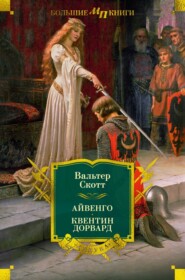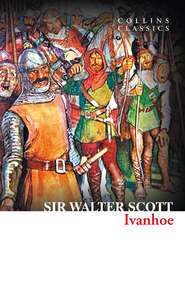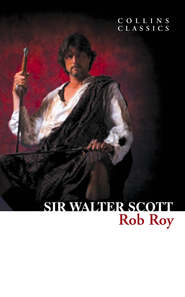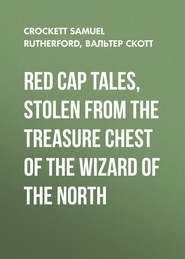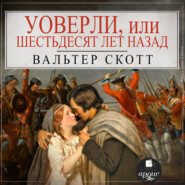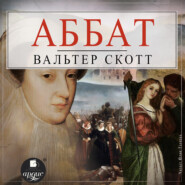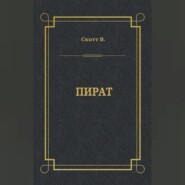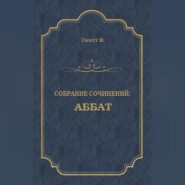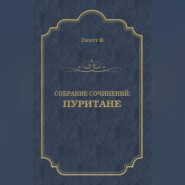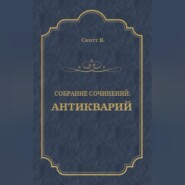По всем вопросам обращайтесь на: info@litportal.ru
(©) 2003-2024.
✖
Rob Roy – Complete
Настройки чтения
Размер шрифта
Высота строк
Поля
Rob Roy – Complete
Вальтер Скотт
Walter Scott
Rob Roy – Complete
VOLUME ONE
For why? Because the good old rule
Sufficeth them; the simple plan,
That they should take who have the power,
And they should keep who can.
Rob Roy’s Grave– Wordsworth
ADVERTISEMENT TO THE FIRST EDITION
When the Editor of the following volumes published, about two years since, the work called the “Antiquary,” he announced that he was, for the last time, intruding upon the public in his present capacity. He might shelter himself under the plea that every anonymous writer is, like the celebrated Junius, only a phantom, and that therefore, although an apparition, of a more benign, as well as much meaner description, he cannot be bound to plead to a charge of inconsistency. A better apology may be found in the imitating the confession of honest Benedict, that, when he said he would die a bachelor, he did not think he should live to be married. The best of all would be, if, as has eminently happened in the case of some distinguished contemporaries, the merit of the work should, in the reader’s estimation, form an excuse for the Author’s breach of promise. Without presuming to hope that this may prove the case, it is only further necessary to mention, that his resolution, like that of Benedict, fell a sacrifice, to temptation at least, if not to stratagem.
It is now about six months since the Author, through the medium of his respectable Publishers, received a parcel of Papers, containing the Outlines of this narrative, with a permission, or rather with a request, couched in highly flattering terms, that they might be given to the Public, with such alterations as should be found suitable.[1 - As it maybe necessary, in the present Edition(1829), to speak upon the square, the Author thinks it proper to own, that the communication alluded to is entirely imaginary.]
These were of course so numerous, that, besides the suppression of names, and of incidents approaching too much to reality, the work may in a great measure be, said to be new written. Several anachronisms have probably crept in during the course of these changes; and the mottoes for the Chapters have been selected without any reference to the supposed date of the incidents. For these, of course, the Editor is responsible. Some others occurred in the original materials, but they are of little consequence. In point of minute accuracy, it may be stated, that the bridge over the Forth, or rather the Avondhu (or Black River), near the hamlet of Aberfoil, had not an existence thirty years ago. It does not, however, become the Editor to be the first to point out these errors; and he takes this public opportunity to thank the unknown and nameless correspondent, to whom the reader will owe the principal share of any amusement which he may derive from the following pages.
1st December 1817.
INTRODUCTION – (1829)
When the author projected this further encroachment on the patience of an indulgent public, he was at some loss for a title; a good name being very nearly of as much consequence in literature as in life. The title of Rob Roy was suggested by the late Mr. Constable, whose sagacity and experience foresaw the germ of popularity which it included.
No introduction can be more appropriate to the work than some account of the singular character whose name is given to the title-page, and who, through good report and bad report, has maintained a wonderful degree of importance in popular recollection. This cannot be ascribed to the distinction of his birth, which, though that of a gentleman, had in it nothing of high destination, and gave him little right to command in his clan. Neither, though he lived a busy, restless, and enterprising life, were his feats equal to those of other freebooters, who have been less distinguished. He owed his fame in a great measure to his residing on the very verge of the Highlands, and playing such pranks in the beginning of the 18th century, as are usually ascribed to Robin Hood in the middle ages, – and that within forty miles of Glasgow, a great commercial city, the seat of a learned university. Thus a character like his, blending the wild virtues, the subtle policy, and unrestrained license of an American Indian, was flourishing in Scotland during the Augustan age of Queen Anne and George I. Addison, it is probable, or Pope, would have been considerably surprised if they had known that there existed in the same island with them a personage of Rob Roy’s peculiar habits and profession. It is this strong contrast betwixt the civilised and cultivated mode of life on the one side of the Highland line, and the wild and lawless adventures which were habitually undertaken and achieved by one who dwelt on the opposite side of that ideal boundary, which creates the interest attached to his name. Hence it is that even yet,
Far and near, through vale and hill,
Are faces that attest the same,
And kindle like a fire new stirr’d,
At sound of Rob Roy’s name.
There were several advantages which Rob Roy enjoyed for sustaining to advantage the character which he assumed.
The most prominent of these was his descent from, and connection with, the clan MacGregor, so famous for their misfortunes, and the indomitable spirit with which they maintained themselves as a clan, linked and banded together in spite of the most severe laws, executed with unheard-of rigour against those who bore this forbidden surname. Their history was that of several others of the original Highland clans, who were suppressed by more powerful neighbours, and either extirpated, or forced to secure themselves by renouncing their own family appellation, and assuming that of the conquerors. The peculiarity in the story of the MacGregors, is their retaining, with such tenacity, their separate existence and union as a clan under circumstances of the utmost urgency. The history of the tribe is briefly as follows – But we must premise that the tale depends in some degree on tradition; therefore, excepting when written documents are, quoted, it must be considered as in some degree dubious.
The sept of MacGregor claimed a descent from Gregor, or Gregorius, third son, it is said, of Alpin King of Scots, who flourished about 787. Hence their original patronymic is MacAlpine, and they are usually termed the Clan Alpine. An individual tribe of them retains the same name. They are accounted one of the most ancient clans in the Highlands, and it is certain they were a people of original Celtic descent, and occupied at one period very extensive possessions in Perthshire and Argyleshire, which they imprudently continued to hold by the coir a glaive, that is, the right of the sword. Their neighbours, the Earls of Argyle and Breadalbane, in the meanwhile, managed to leave the lands occupied by the MacGregors engrossed in those charters which they easily obtained from the Crown; and thus constituted a legal right in their own favour, without much regard to its justice. As opportunity occurred of annoying or extirpating their neighbours, they gradually extended their own domains, by usurping, under the pretext of such royal grants, those of their more uncivilised neighbours. A Sir Duncan Campbell of Lochow, known in the Highlands by the name of Donacha Dhu nan Churraichd, that is, Black Duncan with the Cowl, it being his pleasure to wear such a head-gear, is said to have been peculiarly successful in those acts of spoliation upon the clan MacGregor.
The devoted sept, ever finding themselves iniquitously driven from their possessions, defended themselves by force, and occasionally gained advantages, which they used cruelly enough. This conduct, though natural, considering the country and time, was studiously represented at the capital as arising from an untameable and innate ferocity, which nothing, it was said, could remedy, save cutting off the tribe of MacGregor root and branch.
In an act of Privy Council at Stirling, 22d September 1563, in the reign of Queen Mary, commission is granted to the most powerful nobles, and chiefs of the clans, to pursue the clan Gregor with fire and sword. A similar warrant in 1563, not only grants the like powers to Sir John Campbell of Glenorchy, the descendant of Duncan with the Cowl, but discharges the lieges to receive or assist any of the clan Gregor, or afford them, under any colour whatever, meat, drink, or clothes.
An atrocity which the clan Gregor committed in 1589, by the murder of John Drummond of Drummond-ernoch, a forester of the royal forest of Glenartney, is elsewhere given, with all its horrid circumstances. The clan swore upon the severed head of the murdered man, that they would make common cause in avowing the deed. This led to an act of the Privy Council, directing another crusade against the “wicked clan Gregor, so long continuing in blood, slaughter, theft, and robbery,” in which letters of fire and sword are denounced against them for the space of three years. The reader will find this particular fact illustrated in the Introduction to the Legend of Montrose in the present edition of these Novels.
Other occasions frequently occurred, in which the MacGregors testified contempt for the laws, from which they had often experienced severity, but never protection. Though they were gradually deprived of their possessions, and of all ordinary means of procuring subsistence, they could not, nevertheless, be supposed likely to starve for famine, while they had the means of taking from strangers what they considered as rightfully their own. Hence they became versed in predatory forays, and accustomed to bloodshed. Their passions were eager, and, with a little management on the part of some of their most powerful neighbours, they could easily be hounded out, to use an expressive Scottish phrase, to commit violence, of which the wily instigators took the advantage, and left the ignorant MacGregors an undivided portion of blame and punishment. This policy of pushing on the fierce clans of the Highlands and Borders to break the peace of the country, is accounted by the historian one of the most dangerous practices of his own period, in which the MacGregors were considered as ready agents.
Notwithstanding these severe denunciations, – which were acted upon in the same spirit in which they were conceived, some of the clan still possessed property, and the chief of the name in 1592 is designed Allaster MacGregor of Glenstrae. He is said to have been a brave and active man; but, from the tenor of his confession at his death, appears to have been engaged in many and desperate feuds, one of which finally proved fatal to himself and many of his followers. This was the celebrated conflict at Glenfruin, near the southwestern extremity of Loch Lomond, in the vicinity of which the MacGregors continued to exercise much authority by the coir a glaive, or right of the strongest, which we have already mentioned.
There had been a long and bloody feud betwixt the MacGregors and the Laird of Luss, head of the family of Colquhoun, a powerful race on the lower part of Loch Lomond. The MacGregors’ tradition affirms that the quarrel began on a very trifling subject. Two of the MacGregors being benighted, asked shelter in a house belonging to a dependant of the Colquhouns, and were refused. They then retreated to an out-house, took a wedder from the fold, killed it, and supped off the carcass, for which (it is said) they offered payment to the proprietor. The Laird of Luss seized on the offenders, and, by the summary process which feudal barons had at their command, had them both condemned and executed. The MacGregors verify this account of the feud by appealing to a proverb current amongst them, execrating the hour (Mult dhu an Carbail ghil) that the black wedder with the white tail was ever lambed. To avenge this quarrel, the Laird of MacGregor assembled his clan, to the number of three or four hundred men, and marched towards Luss from the banks of Loch Long, by a pass called Raid na Gael, or the Highlandman’s Pass.
Sir Humphrey Colquhoun received early notice of this incursion, and collected a strong force, more than twice the number of that of the invaders. He had with him the gentlemen of the name of Buchanan, with the Grahams, and other gentry of the Lennox, and a party of the citizens of Dumbarton, under command of Tobias Smollett, a magistrate, or bailie, of that town, and ancestor of the celebrated author.
The parties met in the valley of Glenfruin, which signifies the Glen of Sorrow – a name that seemed to anticipate the event of the day, which, fatal to the conquered party, was at least equally so to the victors, the “babe unborn” of Clan Alpine having reason to repent it. The MacGregors, somewhat discouraged by the appearance of a force much superior to their own, were cheered on to the attack by a Seer, or second-sighted person, who professed that he saw the shrouds of the dead wrapt around their principal opponents. The clan charged with great fury on the front of the enemy, while John MacGregor, with a strong party, made an unexpected attack on the flank. A great part of the Colquhouns’ force consisted in cavalry, which could not act in the boggy ground. They were said to have disputed the field manfully, but were at length completely routed, and a merciless slaughter was exercised on the fugitives, of whom betwixt two and three hundred fell on the field and in the pursuit. If the MacGregors lost, as is averred, only two men slain in the action, they had slight provocation for an indiscriminate massacre. It is said that their fury extended itself to a party of students for clerical orders, who had imprudently come to see the battle. Some doubt is thrown on this fact, from the indictment against the chief of the clan Gregor being silent on the subject, as is the historian Johnston, and a Professor Ross, who wrote an account of the battle twenty-nine years after it was fought. It is, however, constantly averred by the tradition of the country, and a stone where the deed was done is called Leck-a-Mhinisteir, the Minister or Clerk’s Flagstone. The MacGregors, by a tradition which is now found to be inaccurate, impute this cruel action to the ferocity of a single man of their tribe, renowned for size and strength, called Dugald, Ciar Mhor, or the great Mouse-coloured Man. He was MacGregor’s foster-brother, and the chief committed the youths to his charge, with directions to keep them safely till the affray was over. Whether fearful of their escape, or incensed by some sarcasms which they threw on his tribe, or whether out of mere thirst of blood, this savage, while the other MacGregors were engaged in the pursuit, poniarded his helpless and defenceless prisoners. When the chieftain, on his return, demanded where the youths were, the Ciar (pronounced Kiar) Mhor drew out his bloody dirk, saying in Gaelic, “Ask that, and God save me!” The latter words allude to the exclamation which his victims used when he was murdering them. It would seem, therefore, that this horrible part of the story is founded on fact, though the number of the youths so slain is probably exaggerated in the Lowland accounts. The common people say that the blood of the Ciar Mhor’s victims can never be washed off the stone. When MacGregor learnt their fate, he expressed the utmost horror at the deed, and upbraided his foster-brother with having done that which would occasion the destruction of him and his clan. This supposed homicide was the ancestor of Rob Roy, and the tribe from which he was descended. He lies buried at the church of Fortingal, where his sepulchre, covered with a large stone,[2 - Note A. The Grey Stone of MacGregor.] is still shown, and where his great strength and courage are the theme of many traditions.[3 - Note B. Dugald Ciar Mhor.]
MacGregor’s brother was one of the very few of the tribe who was slain. He was buried near the field of battle, and the place is marked by a rude stone, called the Grey Stone of MacGregor.
Sir Humphrey Colquhoun, being well mounted, escaped for the time to the castle of Banochar, or Benechra. It proved no sure defence, however, for he was shortly after murdered in a vault of the castle, – the family annals say by the MacGregors, though other accounts charge the deed upon the MacFarlanes.
This battle of Glenfruin, and the severity which the victors exercised in the pursuit, was reported to King James VI. in a manner the most unfavourable to the clan Gregor, whose general character, being that of lawless though brave men, could not much avail them in such a case. That James might fully understand the extent of the slaughter, the widows of the slain, to the number of eleven score, in deep mourning, riding upon white palfreys, and each bearing her husband’s bloody shirt on a spear, appeared at Stirling, in presence of a monarch peculiarly accessible to such sights of fear and sorrow, to demand vengeance for the death of their husbands, upon those by whom they had been made desolate.
The remedy resorted to was at least as severe as the cruelties which it was designed to punish. By an Act of the Privy Council, dated 3d April 1603, the name of MacGregor was expressly abolished, and those who had hitherto borne it were commanded to change it for other surnames, the pain of death being denounced against those who should call themselves Gregor or MacGregor, the names of their fathers. Under the same penalty, all who had been at the conflict of Glenfruin, or accessory to other marauding parties charged in the act, were prohibited from carrying weapons, except a pointless knife to eat their victuals. By a subsequent act of Council, 24th June 1613, death was denounced against any persons of the tribe formerly called MacGregor, who should presume to assemble in greater numbers than four. Again, by an Act of Parliament, 1617, chap. 26, these laws were continued, and extended to the rising generation, in respect that great numbers of the children of those against whom the acts of Privy Council had been directed, were stated to be then approaching to maturity, who, if permitted to resume the name of their parents, would render the clan as strong as it was before.
The execution of those severe acts was chiefly intrusted in the west to the Earl of Argyle and the powerful clan of Campbell, and to the Earl of Athole and his followers in the more eastern Highlands of Perthshire. The MacGregors failed not to resist with the most determined courage; and many a valley in the West and North Highlands retains memory of the severe conflicts, in which the proscribed clan sometimes obtained transient advantages, and always sold their lives dearly. At length the pride of Allaster MacGregor, the chief of the clan, was so much lowered by the sufferings of his people, that he resolved to surrender himself to the Earl of Argyle, with his principal followers, on condition that they should be sent out of Scotland. If the unfortunate chief’s own account be true, he had more reasons than one for expecting some favour from the Earl, who had in secret advised and encouraged him to many of the desperate actions for which he was now called to so severe a reckoning. But Argyle, as old Birrell expresses himself, kept a Highlandman’s promise with them, fulfilling it to the ear, and breaking it to the sense. MacGregor was sent under a strong guard to the frontier of England, and being thus, in the literal sense, sent out of Scotland, Argyle was judged to have kept faith with him, though the same party which took him there brought him back to Edinburgh in custody.
MacGregor of Glenstrae was tried before the Court of Justiciary, 20th January 1604, and found guilty. He appears to have been instantly conveyed from the bar to the gallows; for Birrell, of the same date, reports that he was hanged at the Cross, and, for distinction sake, was suspended higher by his own height than two of his kindred and friends.
On the 18th of February following, more men of the MacGregors were executed, after a long imprisonment, and several others in the beginning of March.
The Earl of Argyle’s service, in conducting to the surrender of the insolent and wicked race and name of MacGregor, notorious common malefactors, and in the in-bringing of MacGregor, with a great many of the leading men of the clan, worthily executed to death for their offences, is thankfully acknowledged by an Act of Parliament, 1607, chap. 16, and rewarded with a grant of twenty chalders of victual out of the lands of Kintire.
The MacGregors, notwithstanding the letters of fire and sword, and orders for military execution repeatedly directed against them by the Scottish legislature, who apparently lost all the calmness of conscious dignity and security, and could not even name the outlawed clan without vituperation, showed no inclination to be blotted out of the roll of clanship. They submitted to the law, indeed, so far as to take the names of the neighbouring families amongst whom they happened to live, nominally becoming, as the case might render it most convenient, Drummonds, Campbells, Grahams, Buchanans, Stewarts, and the like; but to all intents and purposes of combination and mutual attachment, they remained the clan Gregor, united together for right or wrong, and menacing with the general vengeance of their race, all who committed aggressions against any individual of their number.
They continued to take and give offence with as little hesitation as before the legislative dispersion which had been attempted, as appears from the preamble to statute 1633, chapter 30, setting forth, that the clan Gregor, which had been suppressed and reduced to quietness by the great care of the late King James of eternal memory, had nevertheless broken out again, in the counties of Perth, Stirling, Clackmannan, Monteith, Lennox, Angus, and Mearns; for which reason the statute re-establishes the disabilities attached to the clan, and, grants a new commission for enforcing the laws against that wicked and rebellious race.
Notwithstanding the extreme severities of King James I. and Charles I. against this unfortunate people, who were rendered furious by proscription, and then punished for yielding to the passions which had been wilfully irritated, the MacGregors to a man attached themselves during the civil war to the cause of the latter monarch. Their bards have ascribed this to the native respect of the MacGregors for the crown of Scotland, which their ancestors once wore, and have appealed to their armorial bearings, which display a pine-tree crossed saltire wise with a naked sword, the point of which supports a royal crown. But, without denying that such motives may have had their weight, we are disposed to think, that a war which opened the low country to the raids of the clan Gregor would have more charms for them than any inducement to espouse the cause of the Covenanters, which would have brought them into contact with Highlanders as fierce as themselves, and having as little to lose. Patrick MacGregor, their leader, was the son of a distinguished chief, named Duncan Abbarach, to whom Montrose wrote letters as to his trusty and special friend, expressing his reliance on his devoted loyalty, with an assurance, that when once his Majesty’s affairs were placed upon a permanent footing, the grievances of the clan MacGregor should be redressed.
At a subsequent period of these melancholy times, we find the clan Gregor claiming the immunities of other tribes, when summoned by the Scottish Parliament to resist the invasion of the Commonwealth’s army, in 1651. On the last day of March in that year, a supplication to the King and Parliament, from Calum MacCondachie Vich Euen, and Euen MacCondachie Euen, in their own name, and that of the whole name of MacGregor, set forth, that while, in obedience to the orders of Parliament, enjoining all clans to come out in the present service under their chieftains, for the defence of religion, king, and kingdoms, the petitioners were drawing their men to guard the passes at the head of the river Forth, they were interfered with by the Earl of Athole and the Laird of Buchanan, who had required the attendance of many of the clan Gregor upon their arrays. This interference was, doubtless, owing to the change of name, which seems to have given rise to the claim of the Earl of Athole and the Laird of Buchanan to muster the MacGregors under their banners, as Murrays or Buchanans. It does not appear that the petition of the MacGregors, to be permitted to come out in a body, as other clans, received any answer. But upon the Restoration, King Charles, in the first Scottish Parliament of his reign (statute 1661, chap. 195), annulled the various acts against the clan Gregor, and restored them to the full use of their family name, and the other privileges of liege subjects, setting forth, as a reason for this lenity, that those who were formerly designed MacGregors had, during the late troubles, conducted themselves with such loyalty and affection to his Majesty, as might justly wipe off all memory of former miscarriages, and take away all marks of reproach for the same.
It is singular enough, that it seems to have aggravated the feelings of the non-conforming Presbyterians, when the penalties which were most unjustly imposed upon themselves were relaxed towards the poor MacGregors; – so little are the best men, any more than the worst, able to judge with impartiality of the same measures, as applied to themselves, or to others. Upon the Restoration, an influence inimical to this unfortunate clan, said to be the same with that which afterwards dictated the massacre of Glencoe, occasioned the re-enaction of the penal statutes against the MacGregors. There are no reasons given why these highly penal acts should have been renewed; nor is it alleged that the clan had been guilty of late irregularities. Indeed, there is some reason to think that the clause was formed of set purpose, in a shape which should elude observation; for, though containing conclusions fatal to the rights of so many Scottish subjects, it is neither mentioned in the title nor the rubric of the Act of Parliament in which it occurs, and is thrown briefly in at the close of the statute 1693, chap. 61, entitled, an Act for the Justiciary in the Highlands.
It does not, however, appear that after the Revolution the acts against the clan were severely enforced; and in the latter half of the eighteenth century, they were not enforced at all. Commissioners of supply were named in Parliament by the proscribed title of MacGregor, and decrees of courts of justice were pronounced, and legal deeds entered into, under the same appellative. The MacGregors, however, while the laws continued in the statute-book, still suffered under the deprivation of the name which was their birthright, and some attempts were made for the purpose of adopting another, MacAlpine or Grant being proposed as the title of the whole clan in future. No agreement, however, could be entered into; and the evil was submitted to as a matter of necessity, until full redress was obtained from the British Parliament, by an act abolishing for ever the penal statutes which had been so long imposed upon this ancient race. This statute, well merited by the services of many a gentleman of the clan in behalf of their King and country, was passed, and the clan proceeded to act upon it with the same spirit of ancient times, which had made them suffer severely under a deprivation that would have been deemed of little consequence by a great part of their fellow-subjects.
They entered into a deed recognising John Murray of Lanrick, Esq. (afterwards Sir John MacGregor, Baronet), representative of the family of Glencarnock, as lawfully descended from the ancient stock and blood of the Lairds and Lords of MacGregor, and therefore acknowledged him as their chief on all lawful occasions and causes whatsoever. The deed was subscribed by eight hundred and twenty-six persons of the name of MacGregor, capable of bearing arms. A great many of the clan during the last war formed themselves into what was called the Clan Alpine Regiment, raised in 1799, under the command of their Chief and his brother Colonel MacGregor.
Having briefly noticed the history of this clan, which presents a rare and interesting example of the indelible character of the patriarchal system, the author must now offer some notices of the individual who gives name to these volumes.
In giving an account of a Highlander, his pedigree is first to be considered. That of Rob Roy was deduced from Ciar Mhor, the great mouse-coloured man, who is accused by tradition of having slain the young students at the battle of Glenfruin.
Without puzzling ourselves and our readers with the intricacies of Highland genealogy, it is enough to say, that after the death of Allaster MacGregor of Glenstrae, the clan, discouraged by the unremitting persecution of their enemies, seem not to have had the means of placing themselves under the command of a single chief. According to their places of residence and immediate descent, the several families were led and directed by Chieftains, which, in the Highland acceptation, signifies the head of a particular branch of a tribe, in opposition to Chief, who is the leader and commander of the whole name.
The family and descendants of Dugald Ciar Mhor lived chiefly in the mountains between Loch Lomond and Loch Katrine, and occupied a good deal of property there – whether by sufferance, by the right of the sword, which it was never safe to dispute with them, or by legal titles of various kinds, it would be useless to inquire and unnecessary to detail. Enough; – there they certainly were – a people whom their most powerful neighbours were desirous to conciliate, their friendship in peace being very necessary to the quiet of the vicinage, and their assistance in war equally prompt and effectual.
Rob Roy MacGregor Campbell, which last name he bore in consequence of the Acts of Parliament abolishing his own, was the younger son of Donald MacGregor of Glengyle, said to have been a Lieutenant-Colonel (probably in the service of James II.), by his wife, a daughter of Campbell of Glenfalloch. Rob’s own designation was of Inversnaid; but he appears to have acquired a right of some kind or other to the property or possession of Craig Royston, a domain of rock and forest, lying on the east side of Loch Lomond, where that beautiful lake stretches into the dusky mountains of Glenfalloch.
The time of his birth is uncertain. But he is said to have been active in the scenes of war and plunder which succeeded the Revolution; and tradition affirms him to have been the leader in a predatory incursion into the parish of Kippen, in the Lennox, which took place in the year 1691. It was of almost a bloodless character, only one person losing his life; but from the extent of the depredation, it was long distinguished by the name of the Her’-ship, or devastation, of Kippen.[4 - See Statistcal Account of Scotland, 1st edition, vol. xviii. p. 332. Parish of Kippen.] The time of his death is also uncertain, but as he is said to have survived the year 1733, and died an aged man, it is probable he may have been twenty-five about the time of the Her’-ship of Kippen, which would assign his birth to the middle of the 17th century.
Вальтер Скотт
Walter Scott
Rob Roy – Complete
VOLUME ONE
For why? Because the good old rule
Sufficeth them; the simple plan,
That they should take who have the power,
And they should keep who can.
Rob Roy’s Grave– Wordsworth
ADVERTISEMENT TO THE FIRST EDITION
When the Editor of the following volumes published, about two years since, the work called the “Antiquary,” he announced that he was, for the last time, intruding upon the public in his present capacity. He might shelter himself under the plea that every anonymous writer is, like the celebrated Junius, only a phantom, and that therefore, although an apparition, of a more benign, as well as much meaner description, he cannot be bound to plead to a charge of inconsistency. A better apology may be found in the imitating the confession of honest Benedict, that, when he said he would die a bachelor, he did not think he should live to be married. The best of all would be, if, as has eminently happened in the case of some distinguished contemporaries, the merit of the work should, in the reader’s estimation, form an excuse for the Author’s breach of promise. Without presuming to hope that this may prove the case, it is only further necessary to mention, that his resolution, like that of Benedict, fell a sacrifice, to temptation at least, if not to stratagem.
It is now about six months since the Author, through the medium of his respectable Publishers, received a parcel of Papers, containing the Outlines of this narrative, with a permission, or rather with a request, couched in highly flattering terms, that they might be given to the Public, with such alterations as should be found suitable.[1 - As it maybe necessary, in the present Edition(1829), to speak upon the square, the Author thinks it proper to own, that the communication alluded to is entirely imaginary.]
These were of course so numerous, that, besides the suppression of names, and of incidents approaching too much to reality, the work may in a great measure be, said to be new written. Several anachronisms have probably crept in during the course of these changes; and the mottoes for the Chapters have been selected without any reference to the supposed date of the incidents. For these, of course, the Editor is responsible. Some others occurred in the original materials, but they are of little consequence. In point of minute accuracy, it may be stated, that the bridge over the Forth, or rather the Avondhu (or Black River), near the hamlet of Aberfoil, had not an existence thirty years ago. It does not, however, become the Editor to be the first to point out these errors; and he takes this public opportunity to thank the unknown and nameless correspondent, to whom the reader will owe the principal share of any amusement which he may derive from the following pages.
1st December 1817.
INTRODUCTION – (1829)
When the author projected this further encroachment on the patience of an indulgent public, he was at some loss for a title; a good name being very nearly of as much consequence in literature as in life. The title of Rob Roy was suggested by the late Mr. Constable, whose sagacity and experience foresaw the germ of popularity which it included.
No introduction can be more appropriate to the work than some account of the singular character whose name is given to the title-page, and who, through good report and bad report, has maintained a wonderful degree of importance in popular recollection. This cannot be ascribed to the distinction of his birth, which, though that of a gentleman, had in it nothing of high destination, and gave him little right to command in his clan. Neither, though he lived a busy, restless, and enterprising life, were his feats equal to those of other freebooters, who have been less distinguished. He owed his fame in a great measure to his residing on the very verge of the Highlands, and playing such pranks in the beginning of the 18th century, as are usually ascribed to Robin Hood in the middle ages, – and that within forty miles of Glasgow, a great commercial city, the seat of a learned university. Thus a character like his, blending the wild virtues, the subtle policy, and unrestrained license of an American Indian, was flourishing in Scotland during the Augustan age of Queen Anne and George I. Addison, it is probable, or Pope, would have been considerably surprised if they had known that there existed in the same island with them a personage of Rob Roy’s peculiar habits and profession. It is this strong contrast betwixt the civilised and cultivated mode of life on the one side of the Highland line, and the wild and lawless adventures which were habitually undertaken and achieved by one who dwelt on the opposite side of that ideal boundary, which creates the interest attached to his name. Hence it is that even yet,
Far and near, through vale and hill,
Are faces that attest the same,
And kindle like a fire new stirr’d,
At sound of Rob Roy’s name.
There were several advantages which Rob Roy enjoyed for sustaining to advantage the character which he assumed.
The most prominent of these was his descent from, and connection with, the clan MacGregor, so famous for their misfortunes, and the indomitable spirit with which they maintained themselves as a clan, linked and banded together in spite of the most severe laws, executed with unheard-of rigour against those who bore this forbidden surname. Their history was that of several others of the original Highland clans, who were suppressed by more powerful neighbours, and either extirpated, or forced to secure themselves by renouncing their own family appellation, and assuming that of the conquerors. The peculiarity in the story of the MacGregors, is their retaining, with such tenacity, their separate existence and union as a clan under circumstances of the utmost urgency. The history of the tribe is briefly as follows – But we must premise that the tale depends in some degree on tradition; therefore, excepting when written documents are, quoted, it must be considered as in some degree dubious.
The sept of MacGregor claimed a descent from Gregor, or Gregorius, third son, it is said, of Alpin King of Scots, who flourished about 787. Hence their original patronymic is MacAlpine, and they are usually termed the Clan Alpine. An individual tribe of them retains the same name. They are accounted one of the most ancient clans in the Highlands, and it is certain they were a people of original Celtic descent, and occupied at one period very extensive possessions in Perthshire and Argyleshire, which they imprudently continued to hold by the coir a glaive, that is, the right of the sword. Their neighbours, the Earls of Argyle and Breadalbane, in the meanwhile, managed to leave the lands occupied by the MacGregors engrossed in those charters which they easily obtained from the Crown; and thus constituted a legal right in their own favour, without much regard to its justice. As opportunity occurred of annoying or extirpating their neighbours, they gradually extended their own domains, by usurping, under the pretext of such royal grants, those of their more uncivilised neighbours. A Sir Duncan Campbell of Lochow, known in the Highlands by the name of Donacha Dhu nan Churraichd, that is, Black Duncan with the Cowl, it being his pleasure to wear such a head-gear, is said to have been peculiarly successful in those acts of spoliation upon the clan MacGregor.
The devoted sept, ever finding themselves iniquitously driven from their possessions, defended themselves by force, and occasionally gained advantages, which they used cruelly enough. This conduct, though natural, considering the country and time, was studiously represented at the capital as arising from an untameable and innate ferocity, which nothing, it was said, could remedy, save cutting off the tribe of MacGregor root and branch.
In an act of Privy Council at Stirling, 22d September 1563, in the reign of Queen Mary, commission is granted to the most powerful nobles, and chiefs of the clans, to pursue the clan Gregor with fire and sword. A similar warrant in 1563, not only grants the like powers to Sir John Campbell of Glenorchy, the descendant of Duncan with the Cowl, but discharges the lieges to receive or assist any of the clan Gregor, or afford them, under any colour whatever, meat, drink, or clothes.
An atrocity which the clan Gregor committed in 1589, by the murder of John Drummond of Drummond-ernoch, a forester of the royal forest of Glenartney, is elsewhere given, with all its horrid circumstances. The clan swore upon the severed head of the murdered man, that they would make common cause in avowing the deed. This led to an act of the Privy Council, directing another crusade against the “wicked clan Gregor, so long continuing in blood, slaughter, theft, and robbery,” in which letters of fire and sword are denounced against them for the space of three years. The reader will find this particular fact illustrated in the Introduction to the Legend of Montrose in the present edition of these Novels.
Other occasions frequently occurred, in which the MacGregors testified contempt for the laws, from which they had often experienced severity, but never protection. Though they were gradually deprived of their possessions, and of all ordinary means of procuring subsistence, they could not, nevertheless, be supposed likely to starve for famine, while they had the means of taking from strangers what they considered as rightfully their own. Hence they became versed in predatory forays, and accustomed to bloodshed. Their passions were eager, and, with a little management on the part of some of their most powerful neighbours, they could easily be hounded out, to use an expressive Scottish phrase, to commit violence, of which the wily instigators took the advantage, and left the ignorant MacGregors an undivided portion of blame and punishment. This policy of pushing on the fierce clans of the Highlands and Borders to break the peace of the country, is accounted by the historian one of the most dangerous practices of his own period, in which the MacGregors were considered as ready agents.
Notwithstanding these severe denunciations, – which were acted upon in the same spirit in which they were conceived, some of the clan still possessed property, and the chief of the name in 1592 is designed Allaster MacGregor of Glenstrae. He is said to have been a brave and active man; but, from the tenor of his confession at his death, appears to have been engaged in many and desperate feuds, one of which finally proved fatal to himself and many of his followers. This was the celebrated conflict at Glenfruin, near the southwestern extremity of Loch Lomond, in the vicinity of which the MacGregors continued to exercise much authority by the coir a glaive, or right of the strongest, which we have already mentioned.
There had been a long and bloody feud betwixt the MacGregors and the Laird of Luss, head of the family of Colquhoun, a powerful race on the lower part of Loch Lomond. The MacGregors’ tradition affirms that the quarrel began on a very trifling subject. Two of the MacGregors being benighted, asked shelter in a house belonging to a dependant of the Colquhouns, and were refused. They then retreated to an out-house, took a wedder from the fold, killed it, and supped off the carcass, for which (it is said) they offered payment to the proprietor. The Laird of Luss seized on the offenders, and, by the summary process which feudal barons had at their command, had them both condemned and executed. The MacGregors verify this account of the feud by appealing to a proverb current amongst them, execrating the hour (Mult dhu an Carbail ghil) that the black wedder with the white tail was ever lambed. To avenge this quarrel, the Laird of MacGregor assembled his clan, to the number of three or four hundred men, and marched towards Luss from the banks of Loch Long, by a pass called Raid na Gael, or the Highlandman’s Pass.
Sir Humphrey Colquhoun received early notice of this incursion, and collected a strong force, more than twice the number of that of the invaders. He had with him the gentlemen of the name of Buchanan, with the Grahams, and other gentry of the Lennox, and a party of the citizens of Dumbarton, under command of Tobias Smollett, a magistrate, or bailie, of that town, and ancestor of the celebrated author.
The parties met in the valley of Glenfruin, which signifies the Glen of Sorrow – a name that seemed to anticipate the event of the day, which, fatal to the conquered party, was at least equally so to the victors, the “babe unborn” of Clan Alpine having reason to repent it. The MacGregors, somewhat discouraged by the appearance of a force much superior to their own, were cheered on to the attack by a Seer, or second-sighted person, who professed that he saw the shrouds of the dead wrapt around their principal opponents. The clan charged with great fury on the front of the enemy, while John MacGregor, with a strong party, made an unexpected attack on the flank. A great part of the Colquhouns’ force consisted in cavalry, which could not act in the boggy ground. They were said to have disputed the field manfully, but were at length completely routed, and a merciless slaughter was exercised on the fugitives, of whom betwixt two and three hundred fell on the field and in the pursuit. If the MacGregors lost, as is averred, only two men slain in the action, they had slight provocation for an indiscriminate massacre. It is said that their fury extended itself to a party of students for clerical orders, who had imprudently come to see the battle. Some doubt is thrown on this fact, from the indictment against the chief of the clan Gregor being silent on the subject, as is the historian Johnston, and a Professor Ross, who wrote an account of the battle twenty-nine years after it was fought. It is, however, constantly averred by the tradition of the country, and a stone where the deed was done is called Leck-a-Mhinisteir, the Minister or Clerk’s Flagstone. The MacGregors, by a tradition which is now found to be inaccurate, impute this cruel action to the ferocity of a single man of their tribe, renowned for size and strength, called Dugald, Ciar Mhor, or the great Mouse-coloured Man. He was MacGregor’s foster-brother, and the chief committed the youths to his charge, with directions to keep them safely till the affray was over. Whether fearful of their escape, or incensed by some sarcasms which they threw on his tribe, or whether out of mere thirst of blood, this savage, while the other MacGregors were engaged in the pursuit, poniarded his helpless and defenceless prisoners. When the chieftain, on his return, demanded where the youths were, the Ciar (pronounced Kiar) Mhor drew out his bloody dirk, saying in Gaelic, “Ask that, and God save me!” The latter words allude to the exclamation which his victims used when he was murdering them. It would seem, therefore, that this horrible part of the story is founded on fact, though the number of the youths so slain is probably exaggerated in the Lowland accounts. The common people say that the blood of the Ciar Mhor’s victims can never be washed off the stone. When MacGregor learnt their fate, he expressed the utmost horror at the deed, and upbraided his foster-brother with having done that which would occasion the destruction of him and his clan. This supposed homicide was the ancestor of Rob Roy, and the tribe from which he was descended. He lies buried at the church of Fortingal, where his sepulchre, covered with a large stone,[2 - Note A. The Grey Stone of MacGregor.] is still shown, and where his great strength and courage are the theme of many traditions.[3 - Note B. Dugald Ciar Mhor.]
MacGregor’s brother was one of the very few of the tribe who was slain. He was buried near the field of battle, and the place is marked by a rude stone, called the Grey Stone of MacGregor.
Sir Humphrey Colquhoun, being well mounted, escaped for the time to the castle of Banochar, or Benechra. It proved no sure defence, however, for he was shortly after murdered in a vault of the castle, – the family annals say by the MacGregors, though other accounts charge the deed upon the MacFarlanes.
This battle of Glenfruin, and the severity which the victors exercised in the pursuit, was reported to King James VI. in a manner the most unfavourable to the clan Gregor, whose general character, being that of lawless though brave men, could not much avail them in such a case. That James might fully understand the extent of the slaughter, the widows of the slain, to the number of eleven score, in deep mourning, riding upon white palfreys, and each bearing her husband’s bloody shirt on a spear, appeared at Stirling, in presence of a monarch peculiarly accessible to such sights of fear and sorrow, to demand vengeance for the death of their husbands, upon those by whom they had been made desolate.
The remedy resorted to was at least as severe as the cruelties which it was designed to punish. By an Act of the Privy Council, dated 3d April 1603, the name of MacGregor was expressly abolished, and those who had hitherto borne it were commanded to change it for other surnames, the pain of death being denounced against those who should call themselves Gregor or MacGregor, the names of their fathers. Under the same penalty, all who had been at the conflict of Glenfruin, or accessory to other marauding parties charged in the act, were prohibited from carrying weapons, except a pointless knife to eat their victuals. By a subsequent act of Council, 24th June 1613, death was denounced against any persons of the tribe formerly called MacGregor, who should presume to assemble in greater numbers than four. Again, by an Act of Parliament, 1617, chap. 26, these laws were continued, and extended to the rising generation, in respect that great numbers of the children of those against whom the acts of Privy Council had been directed, were stated to be then approaching to maturity, who, if permitted to resume the name of their parents, would render the clan as strong as it was before.
The execution of those severe acts was chiefly intrusted in the west to the Earl of Argyle and the powerful clan of Campbell, and to the Earl of Athole and his followers in the more eastern Highlands of Perthshire. The MacGregors failed not to resist with the most determined courage; and many a valley in the West and North Highlands retains memory of the severe conflicts, in which the proscribed clan sometimes obtained transient advantages, and always sold their lives dearly. At length the pride of Allaster MacGregor, the chief of the clan, was so much lowered by the sufferings of his people, that he resolved to surrender himself to the Earl of Argyle, with his principal followers, on condition that they should be sent out of Scotland. If the unfortunate chief’s own account be true, he had more reasons than one for expecting some favour from the Earl, who had in secret advised and encouraged him to many of the desperate actions for which he was now called to so severe a reckoning. But Argyle, as old Birrell expresses himself, kept a Highlandman’s promise with them, fulfilling it to the ear, and breaking it to the sense. MacGregor was sent under a strong guard to the frontier of England, and being thus, in the literal sense, sent out of Scotland, Argyle was judged to have kept faith with him, though the same party which took him there brought him back to Edinburgh in custody.
MacGregor of Glenstrae was tried before the Court of Justiciary, 20th January 1604, and found guilty. He appears to have been instantly conveyed from the bar to the gallows; for Birrell, of the same date, reports that he was hanged at the Cross, and, for distinction sake, was suspended higher by his own height than two of his kindred and friends.
On the 18th of February following, more men of the MacGregors were executed, after a long imprisonment, and several others in the beginning of March.
The Earl of Argyle’s service, in conducting to the surrender of the insolent and wicked race and name of MacGregor, notorious common malefactors, and in the in-bringing of MacGregor, with a great many of the leading men of the clan, worthily executed to death for their offences, is thankfully acknowledged by an Act of Parliament, 1607, chap. 16, and rewarded with a grant of twenty chalders of victual out of the lands of Kintire.
The MacGregors, notwithstanding the letters of fire and sword, and orders for military execution repeatedly directed against them by the Scottish legislature, who apparently lost all the calmness of conscious dignity and security, and could not even name the outlawed clan without vituperation, showed no inclination to be blotted out of the roll of clanship. They submitted to the law, indeed, so far as to take the names of the neighbouring families amongst whom they happened to live, nominally becoming, as the case might render it most convenient, Drummonds, Campbells, Grahams, Buchanans, Stewarts, and the like; but to all intents and purposes of combination and mutual attachment, they remained the clan Gregor, united together for right or wrong, and menacing with the general vengeance of their race, all who committed aggressions against any individual of their number.
They continued to take and give offence with as little hesitation as before the legislative dispersion which had been attempted, as appears from the preamble to statute 1633, chapter 30, setting forth, that the clan Gregor, which had been suppressed and reduced to quietness by the great care of the late King James of eternal memory, had nevertheless broken out again, in the counties of Perth, Stirling, Clackmannan, Monteith, Lennox, Angus, and Mearns; for which reason the statute re-establishes the disabilities attached to the clan, and, grants a new commission for enforcing the laws against that wicked and rebellious race.
Notwithstanding the extreme severities of King James I. and Charles I. against this unfortunate people, who were rendered furious by proscription, and then punished for yielding to the passions which had been wilfully irritated, the MacGregors to a man attached themselves during the civil war to the cause of the latter monarch. Their bards have ascribed this to the native respect of the MacGregors for the crown of Scotland, which their ancestors once wore, and have appealed to their armorial bearings, which display a pine-tree crossed saltire wise with a naked sword, the point of which supports a royal crown. But, without denying that such motives may have had their weight, we are disposed to think, that a war which opened the low country to the raids of the clan Gregor would have more charms for them than any inducement to espouse the cause of the Covenanters, which would have brought them into contact with Highlanders as fierce as themselves, and having as little to lose. Patrick MacGregor, their leader, was the son of a distinguished chief, named Duncan Abbarach, to whom Montrose wrote letters as to his trusty and special friend, expressing his reliance on his devoted loyalty, with an assurance, that when once his Majesty’s affairs were placed upon a permanent footing, the grievances of the clan MacGregor should be redressed.
At a subsequent period of these melancholy times, we find the clan Gregor claiming the immunities of other tribes, when summoned by the Scottish Parliament to resist the invasion of the Commonwealth’s army, in 1651. On the last day of March in that year, a supplication to the King and Parliament, from Calum MacCondachie Vich Euen, and Euen MacCondachie Euen, in their own name, and that of the whole name of MacGregor, set forth, that while, in obedience to the orders of Parliament, enjoining all clans to come out in the present service under their chieftains, for the defence of religion, king, and kingdoms, the petitioners were drawing their men to guard the passes at the head of the river Forth, they were interfered with by the Earl of Athole and the Laird of Buchanan, who had required the attendance of many of the clan Gregor upon their arrays. This interference was, doubtless, owing to the change of name, which seems to have given rise to the claim of the Earl of Athole and the Laird of Buchanan to muster the MacGregors under their banners, as Murrays or Buchanans. It does not appear that the petition of the MacGregors, to be permitted to come out in a body, as other clans, received any answer. But upon the Restoration, King Charles, in the first Scottish Parliament of his reign (statute 1661, chap. 195), annulled the various acts against the clan Gregor, and restored them to the full use of their family name, and the other privileges of liege subjects, setting forth, as a reason for this lenity, that those who were formerly designed MacGregors had, during the late troubles, conducted themselves with such loyalty and affection to his Majesty, as might justly wipe off all memory of former miscarriages, and take away all marks of reproach for the same.
It is singular enough, that it seems to have aggravated the feelings of the non-conforming Presbyterians, when the penalties which were most unjustly imposed upon themselves were relaxed towards the poor MacGregors; – so little are the best men, any more than the worst, able to judge with impartiality of the same measures, as applied to themselves, or to others. Upon the Restoration, an influence inimical to this unfortunate clan, said to be the same with that which afterwards dictated the massacre of Glencoe, occasioned the re-enaction of the penal statutes against the MacGregors. There are no reasons given why these highly penal acts should have been renewed; nor is it alleged that the clan had been guilty of late irregularities. Indeed, there is some reason to think that the clause was formed of set purpose, in a shape which should elude observation; for, though containing conclusions fatal to the rights of so many Scottish subjects, it is neither mentioned in the title nor the rubric of the Act of Parliament in which it occurs, and is thrown briefly in at the close of the statute 1693, chap. 61, entitled, an Act for the Justiciary in the Highlands.
It does not, however, appear that after the Revolution the acts against the clan were severely enforced; and in the latter half of the eighteenth century, they were not enforced at all. Commissioners of supply were named in Parliament by the proscribed title of MacGregor, and decrees of courts of justice were pronounced, and legal deeds entered into, under the same appellative. The MacGregors, however, while the laws continued in the statute-book, still suffered under the deprivation of the name which was their birthright, and some attempts were made for the purpose of adopting another, MacAlpine or Grant being proposed as the title of the whole clan in future. No agreement, however, could be entered into; and the evil was submitted to as a matter of necessity, until full redress was obtained from the British Parliament, by an act abolishing for ever the penal statutes which had been so long imposed upon this ancient race. This statute, well merited by the services of many a gentleman of the clan in behalf of their King and country, was passed, and the clan proceeded to act upon it with the same spirit of ancient times, which had made them suffer severely under a deprivation that would have been deemed of little consequence by a great part of their fellow-subjects.
They entered into a deed recognising John Murray of Lanrick, Esq. (afterwards Sir John MacGregor, Baronet), representative of the family of Glencarnock, as lawfully descended from the ancient stock and blood of the Lairds and Lords of MacGregor, and therefore acknowledged him as their chief on all lawful occasions and causes whatsoever. The deed was subscribed by eight hundred and twenty-six persons of the name of MacGregor, capable of bearing arms. A great many of the clan during the last war formed themselves into what was called the Clan Alpine Regiment, raised in 1799, under the command of their Chief and his brother Colonel MacGregor.
Having briefly noticed the history of this clan, which presents a rare and interesting example of the indelible character of the patriarchal system, the author must now offer some notices of the individual who gives name to these volumes.
In giving an account of a Highlander, his pedigree is first to be considered. That of Rob Roy was deduced from Ciar Mhor, the great mouse-coloured man, who is accused by tradition of having slain the young students at the battle of Glenfruin.
Without puzzling ourselves and our readers with the intricacies of Highland genealogy, it is enough to say, that after the death of Allaster MacGregor of Glenstrae, the clan, discouraged by the unremitting persecution of their enemies, seem not to have had the means of placing themselves under the command of a single chief. According to their places of residence and immediate descent, the several families were led and directed by Chieftains, which, in the Highland acceptation, signifies the head of a particular branch of a tribe, in opposition to Chief, who is the leader and commander of the whole name.
The family and descendants of Dugald Ciar Mhor lived chiefly in the mountains between Loch Lomond and Loch Katrine, and occupied a good deal of property there – whether by sufferance, by the right of the sword, which it was never safe to dispute with them, or by legal titles of various kinds, it would be useless to inquire and unnecessary to detail. Enough; – there they certainly were – a people whom their most powerful neighbours were desirous to conciliate, their friendship in peace being very necessary to the quiet of the vicinage, and their assistance in war equally prompt and effectual.
Rob Roy MacGregor Campbell, which last name he bore in consequence of the Acts of Parliament abolishing his own, was the younger son of Donald MacGregor of Glengyle, said to have been a Lieutenant-Colonel (probably in the service of James II.), by his wife, a daughter of Campbell of Glenfalloch. Rob’s own designation was of Inversnaid; but he appears to have acquired a right of some kind or other to the property or possession of Craig Royston, a domain of rock and forest, lying on the east side of Loch Lomond, where that beautiful lake stretches into the dusky mountains of Glenfalloch.
The time of his birth is uncertain. But he is said to have been active in the scenes of war and plunder which succeeded the Revolution; and tradition affirms him to have been the leader in a predatory incursion into the parish of Kippen, in the Lennox, which took place in the year 1691. It was of almost a bloodless character, only one person losing his life; but from the extent of the depredation, it was long distinguished by the name of the Her’-ship, or devastation, of Kippen.[4 - See Statistcal Account of Scotland, 1st edition, vol. xviii. p. 332. Parish of Kippen.] The time of his death is also uncertain, but as he is said to have survived the year 1733, and died an aged man, it is probable he may have been twenty-five about the time of the Her’-ship of Kippen, which would assign his birth to the middle of the 17th century.







